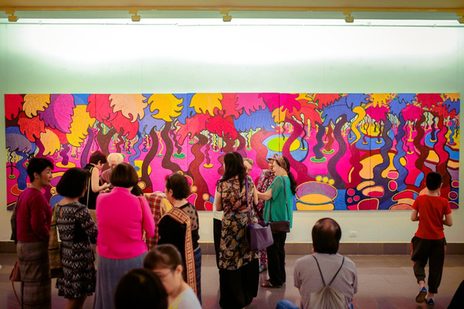“Dancing colors of nature” was the theme of a fine art exhibition showcasing finest paintings by Vietnamese artist Hoang Dinh and his Dutch colleague Somsak Chaituch in October, 2018 at the Vietnam Fine Arts Museum.

Though coming from different countries, the two artists decided to co-host the exhibition, for they shared things in common. Firstly, Dinh and Somsak studied in the Netherlands and both are interested in merging Eastern and Western features in their art works while looking for great inspiration from music in their painting. Furthermore, they’ve won many international awards on contemporary art and both shown their desire to dedicate the exhibition to Hanoi. One interesting is that though sharing the same way of expression, it can be seen that there are two unique characteristics and personalities in each of the painters’ works.
Music is the art for the ears and painting is the visual art. In fact, music and painting were born inseparably, as viewers can feel music in paintings and see images in music. Since the existence of music and painting, creative artists have always tried to blur the border between them, but it was a challenging job. Previously, painters just made efforts in approaching music as a composition theme for painting. It means that painters only drew the still-life of music-related things, such as instruments, portraits of musicians, instrumentalists, singers and music-related activities, not a painting that could arouse viewers’ hearing, making viewers feel they are listening to the sound of music. To create such brilliant art works, painters must have deep insight into the sound, rhythm, melody, and harmony, which are specific languages of music, putting them together in their works. It was coincident that the two artists shared the same passion for using paintings to portrait music and creating unique works that not only capture viewers’ eyes, but also arouse their hearing. And the result of their hard work is a collection of large-sized fine art works at the exhibition.
Born in Thailand, Somsak, however, enjoyed modern Western education and became a citizen of the Netherlands later. That’s why he was passionate about smoothly merging the East and the West in his fine art works, especially after he recovered from a serious illness. To realize his aspiration, Somsak chose abstract trend to reflect the combination of the language of music (symphony and jazz) and that of painting (on Thai traditional sarongs) that he called “music for the eyes.”
Somsak brought seven finest paintings to the exhibition. All of them vividly reflected the strong and persistent “marriage” between music and painting. Looking at the lay-outs of his large-sized works, viewers felt they are attending a jazz performance in which the melody is reflected by curving and twisted lines on smooth color lines representing accompanying notes. Some others look like the Thai people’s widespread traditional sarongs. At a glance, they looked like a copy of decorative weaving products with brocade patterns. At a closer look, it seems that the color dots and brush strokes in the paintings represent the notes and the rhythm of a song, perfectly mixed. While producing the perfect mixture of music and painting, the Dutch artist shows his art knack of creating a harmony between liberalness and precision in lay-out and carefulness in mixing colors and employing paint brushes. Enjoying Somsak’s art works, viewers feel it seems that they are lured into an adventure of music and painting. That is the contemporary impressionism named Somsak.
The love story between music and painting in Hoang Dinh’s paintings is told in a different way. As a son of the beach district of Do Son, Hai Phong city, Dinh’s inspiration, feelings and taste for beauty came from sea waves and wind which have created his works’ characteristics. While holding the paint brush, Dinh is lured to the world of sounds and colors. That’s why he chose to follow expressionism.
If his landscape paintings on paper last year left strong impression on art lovers, then this year’s ones is seen as a breakthrough as they give viewers the feelings of joy and happiness. He calls it “the dancing of colors.”
Interested in music, Dinh intends and does portrait sonatas and symphonies in colors. With his specific painting techniques and deep understanding of his subject, each of his seven large-sized oil paintings at the exhibition is like a lake of music, a forest of music, or greater - a sea of music - in the form of colors. It seemed that each dot of color and each brush stroke are dancing and singing and the subjects in the painting are sparkling and flickering in waves of music.
Dinh’s contemporary painting techniques have helped create unique works that arouse viewers’ endless waves of improvised emotions and create a joyful symphony of colors.
“Dancing Colors” and “music for the eyes” have been intertwined in an interesting fine art exhibition of the two artists sharing various similarities, but still different in characteristics and personality.
Author: Chu Van Son
Translated by Tran Hoai
VNQD